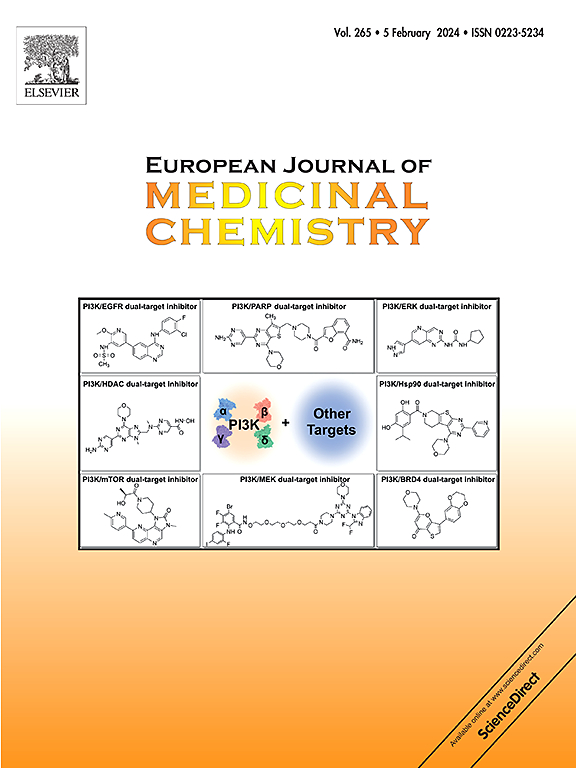Marine natural products as potential anti-Pseudomonas aeruginosa agents: challenges and advances
IF 6
2区 医学
Q1 CHEMISTRY, MEDICINAL
引用次数: 0
Abstract
Antimicrobial resistance (AMR) has become a pressing need to address in the major global public health challenges, posing a serious threat to human health. Pseudomonas aeruginosa (PA) is one of the most concerning Gram-negative pathogens and is typically treated with broad-spectrum antibiotics. PA exhibits resistance to multiple antibiotics, multifactorial virulence, and dynamic hyperadaptation, which results in a particularly formidable challenge in eliminating PA from patients. The problem of drug resistance is becoming increasingly serious, and the development of new antibiotics is extremely lagging behind, resulting in no drug with a new structure and mechanism being approved for the treatment of infections caused by drug-resistant Gram-negative bacteria over the past half-century. Consequently, the development of new antibiotics is of utmost urgency and importance. Marine natural products (MNPs) have become an important source for developing new antibiotics due to their unique properties. So far, 44 potential molecules with significant anti-PA activity have been isolated from marine organisms, of which 19 have been reported as quorum-sensing system inhibitors (QSIs) with potential for further development. In this review, we provide a comprehensive summary of the current status of drug resistance, pathogenic mechanisms, and resistance mechanisms associated with PA infections. We also highlight the challenges and opportunities presented by MNPs in the development of anti-PA drugs, and offer recommendations to accelerate the antibiotic development process, thereby providing valuable insights for the study and exploitation of novel antibiotics.


海洋天然产物作为潜在的抗铜绿假单胞菌剂:挑战与进展
抗菌素耐药性(AMR)已成为全球重大公共卫生挑战中亟待解决的问题,对人类健康构成严重威胁。铜绿假单胞菌(PA)是最受关注的革兰氏阴性病原体之一,通常使用广谱抗生素治疗。PA表现出对多种抗生素的耐药性、多因子毒力和动态超适应,这给从患者体内消除PA带来了特别艰巨的挑战。耐药问题日益严重,新型抗生素的开发极其滞后,导致半个世纪以来没有一种具有新结构和新机制的药物被批准用于治疗耐药革兰氏阴性菌引起的感染。因此,开发新的抗生素是极其紧迫和重要的。海洋天然产物(MNPs)由于其独特的性质,已成为开发新型抗生素的重要来源。迄今为止,已从海洋生物中分离到44个具有显著抗pa活性的潜在分子,其中19个被报道为具有进一步开发潜力的群体感应系统抑制剂(qsi)。在这篇综述中,我们全面总结了目前与PA感染相关的耐药现状、致病机制和耐药机制。我们还强调了MNPs在抗pa药物开发中的挑战和机遇,并提出了加快抗生素开发进程的建议,从而为新型抗生素的研究和开发提供了有价值的见解。
本文章由计算机程序翻译,如有差异,请以英文原文为准。
求助全文
约1分钟内获得全文
求助全文
来源期刊
CiteScore
11.70
自引率
9.00%
发文量
863
审稿时长
29 days
期刊介绍:
The European Journal of Medicinal Chemistry is a global journal that publishes studies on all aspects of medicinal chemistry. It provides a medium for publication of original papers and also welcomes critical review papers.
A typical paper would report on the organic synthesis, characterization and pharmacological evaluation of compounds. Other topics of interest are drug design, QSAR, molecular modeling, drug-receptor interactions, molecular aspects of drug metabolism, prodrug synthesis and drug targeting. The journal expects manuscripts to present the rational for a study, provide insight into the design of compounds or understanding of mechanism, or clarify the targets.

 求助内容:
求助内容: 应助结果提醒方式:
应助结果提醒方式:


